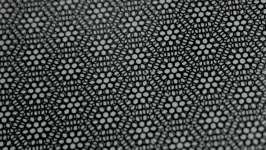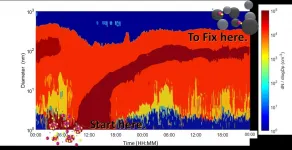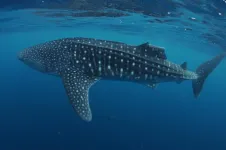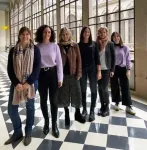Saki monkeys get screen time for more control over their lives in captivity
Computer scientists have designed a video player that the small primates can activate on demand
2021-02-23
(Press-News.org) Helsinki, Finland--Technology helps humans maintain connections, get work done, and relax after a long day. How it can best improve the lives of animals, particularly those in captivity, however, has remained an open question.
Scientists from Aalto University, in collaboration with Korkeasaari Zoo, have designed and built an on-demand video device for white-faced saki monkeys to activate as and when they like. While enrichment systems for zoo animals have been around for some time, very few offer animals the ability to choose when and how they use the device, even though choice and control are known to promote animal welfare.
'We were very much interested in how we can give animals control over their environment and especially how they can control technology. Typically, when we use technology with animals, we use it on them, so we play them sounds or video, rather than giving them the option of controlling the technology themselves,' says Ilyena Hirskyj-Douglas, lead author and visiting researcher at Aalto University.
The device, a tunnel built of plywood and acrylic and equipped with a monitor, camera and sensors to monitor the use of space, was placed in the saki habitat at Korkeasaari Zoo, located in the Finnish capital of Helsinki. It was up to the animals to decide whether they wanted to step inside the device - the equivalent of pressing play - to see the video of the week. During the study, the device played five different kinds of scenes: sealife like fish and jellyfish, wiggly worms, other zoo animals like zebras, makis and dear, abstract art, or lush forests.
'We got interesting results. First of all, we learned that the monkeys do pay attention to the screen; they watch it and touch it. We also suspect they recognize objects on the screen. One of the videos we had featured meal worms - an everyday meal for them. They actually tried to lick the screen and even went around the tunnel to see if the worms were behind it,' explains Vilma Kankaanpää, co-author of the paper and Master's student at Aalto University.
Despite keen observation, it's difficult to say with certainty which video the monkeys liked the most. They spent most of their time watching slithering worms or underwater scenes but these were also the videos accessible at the middle of the study, when they were accustomed to using the device, but it was still fairly new.
The researchers, however, found that, in comparison to the no-video control condition, the sakis scratched themselves significantly less often when presented with video content. For monkeys in captivity, scratching can be a sign of stress.
While a causal link between specific activities and animals' stress levels cannot be made, one thing is sure: different types of stimuli gives them new things to do, which is important for their wellbeing.
The researchers based the video device on their previous research published in autumn 2020, in which they used the same tunnel-shaped device to play the sakis different sounds and music. At the time, researchers found that monkeys listened more to the sounds of traffic than to the sounds of rain, music, or silence.
Kirsi Pynnönen-Oudman, research coordinator at Korkeasaari Zoo, believes that both audio and video can be used to enrich the lives of primates and possibly some birds, such as parrots and crows, living at their facilities also in the future.
'The equipment must, of course, withstand the handling of animals, and those which have, for example, sharp teeth must have their own equipment. The advantage is that the availability of video and audio content is almost unlimited, so the use of the device is not expensive,' Pynnönen-Oudman says.
The study has been published in the scientific journal Animals.
INFORMATION:
ELSE PRESS RELEASES FROM THIS DATE:
2021-02-23
U.S. policies in the Middle East are built on outdated "legacy" aid packages, massive arms sales and a disproportionate focus on the Iranian threat that fail to advance American interests - or help the region's people - and need to be rethought, according to a new RAND Corporation report.
The United States devotes an overwhelming share of foreign military financing to just three countries - Israel, Egypt and Jordan, which received 81% of the $6 billion spent globally in 2019. If policymakers were to pursue an alternative strategy outlined by RAND researchers, ...
2021-02-23
Graphene, a two-dimensional material composed exclusively of carbon, has revealed extraordinary properties, including thermal and electrical conductivity, transparency, and flexibility. When combined, these properties become particularly interesting in the age of touch screens and flexible electronics! 'Unlike 3D materials, graphene has a height reduced to the ultimate dimension of the atom. It's therefore a carbon atom plane,' explains Prof. Jean-Christophe Charlier, a specialist in nanoscopic physics at the Institute of Condensed Matter and Nanosciences of UCLouvain.
In a study published in Nature, the scientist and his team dissected the behaviour of electrons when two layers of graphene superimposed at an ...
2021-02-23
Its muscular body shape and large pectoral fins are perfect for long-distance travel, yet movement patterns of the whitespotted eagle ray (Aetobatus narinari) remain a mystery. Researchers from Florida Atlantic University's Harbor Branch Oceanographic Institute in collaboration with Mote Marine Laboratory & Aquarium, the University of Florida and the Florida Fish and Wildlife Conservation Commission, are the first to conduct a multiyear study examining large-scale movements of whitespotted eagle rays in United States waters.
Between 2016 and 2018, scientists fitted 54 rays with acoustic transmitters ...
2021-02-23
Doha, Qatar - (February 23, 2021) - A group of researchers at Qatar Foundation have reported the first and largest genetic association study in the Middle East, that has been published online in Nature Communications - a leading a peer-reviewed, open access, scientific journal published by Nature Research.
The study titled "Whole genome sequencing in the Middle Eastern Qatari population identifies genetic associations with 45 clinically relevant traits" highlights a vital piece of information wherein now there is a better understanding of the genetic risk factors that are specific to the Arab population, including those that are shared with other ethnicities.
Qatar was among the first countries to launch its own large-scale, national genome project. Qatar Genome ...
2021-02-23
A recent genetic study at the University of Helsinki provides new information on the occurrence of a DVL2 gene defect associated with a screw tail and its relevance to canine constitution and health. The variant was found in several Bulldog and Pit Bull type breeds, and it was shown to result in caudal vertebral anomalies and shortening of the muzzle. The DLV2 variant may also affect the development of the heart.
Dog breeding is often focused on appearance. In some breeds, the ideal body shape is bulky, with a broad head and short muzzle, short legs and a very short and kinked tail, also known as a "screw tail". In a previous study in the United States, screw tail was linked to a variant in the DVL2 gene. The variant has become enriched ...
2021-02-23
According to recent estimates, there will be roughly 10 billion people to feed in 2050. Agricultural production will need to increase by almost 56% to guarantee food security globally, without converting more land for agriculture (in line with environmental and climate targets). This unprecedented challenge has ushered in the era of "smart agriculture," which promises to revolutionize food production by combining agricultural techniques with information technology, automation, and artificial intelligence. This new era, called "Agriculture 4.0," could ensure sustainable food production for the entire world. However, as communities gradually embrace smart agriculture, it is important to understand how to manage the security and privacy risks associated with the integration of ...
2021-02-23
Washington, DC / New Delhi, India - Researchers at CDDEP, in collaboration with leading experts in the field, have produced the "Infectious Diseases in the South-East Asia Region" report, which examines cross-boundary challenges in communicable disease control in countries in the South-and South-East Asia region. The report emphasizes infectious diseases related to other sources of disease burden in the region and communicates overall trends in the health and economic burden they impose.
Despite substantial progress in recent years, which has seen reductions in deaths from HIV and malaria and an increase ...
2021-02-23
Researchers of the University of Helsinki have resolved for the first time, how the ultrafine particles of atmosphere effect on the climate and health.
Atmospheric air pollution kills more than 10,000 people every day. The biggest threat to human health has been assumed to be the mass accumulation of atmospheric particles with diameter smaller 2.5 μm: the higher the mass and loss of visibility, the bigger the threat.
The researchers of the Institute for Atmospheric and Earth System Research (INAR) at the University of Helsinki together with collaborators in China discovered that if we want to solve the accumulation of the biggest particles, we need to start with the smallest.
Until recent ...
2021-02-23
A new study has for the first time explored the rate at which the world's largest fish, the endangered whale shark, can recover from its injuries. The findings reveal that lacerations and abrasions, increasingly caused through collisions with boats, can heal in a matter of weeks and researchers found evidence of partially removed dorsal fins re-growing.
This work, published in the journal Conservation Physiology, comes at a critical time for these large sharks, that can reach lengths of up to 18 metres. Other recent studies have shown that as their popularity within the wildlife tourism sector increases, so do interactions with humans and boat traffic. As a result, these ...
2021-02-23
Huntington's disease is caused by a mutation in the Huntingtin gene (HTT), which appears in adults and features motor, cognitive and psychiatric alterations. The origin of this disease has been associated with the anomalous functioning of the mutated protein: mHTT, but recent data showed the involvement of other molecular mechanisms.
A new study conducted by the University of Barcelona has identified a type of ribonucleic acid (RNA) as a potential therapeutic target for the treatment of the disease. These are the small RNA, or sRNAs, molecules that do not code proteins but have important functions in the regulation of gene expression. According to the study, sRNAs would ...
LAST 30 PRESS RELEASES:
[Press-News.org] Saki monkeys get screen time for more control over their lives in captivity
Computer scientists have designed a video player that the small primates can activate on demand





